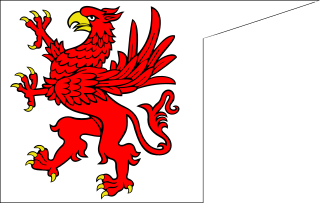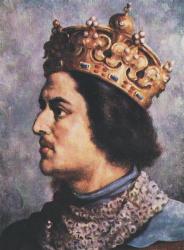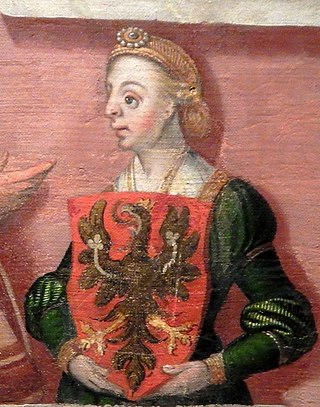Related Research Articles

Przemysł II was the Duke of Poznań from 1257–1279, of Greater Poland from 1279 to 1296, of Kraków from 1290 to 1291, and Gdańsk Pomerania (Pomerelia) from 1294 to 1296, and then King of Poland from 1295 until his death. After a long period of Polish high dukes and two nominal kings, he was the first to obtain the hereditary title of king, and thus to return Poland to the rank of kingdom. A member of the Greater Poland branch of the House of Piast as the only son of Duke Przemysł I and the Silesian princess Elisabeth, he was born posthumously; for this reason he was brought up at the court of his uncle Bolesław the Pious and received his own district to rule, the Duchy of Poznań in 1273. Six years later, after the death of his uncle, he also obtained the Duchy of Kalisz.

Przemysł I, a member of the Piast dynasty, was Duke of Greater Poland from 1239 until his death, from 1241 with his brother Bolesław the Pious as co-ruler. He was able to re-acquire large parts of Greater Poland, ruling as Duke of Poznań and Gniezno from 1247 and, upon several inheritance conflicts with his brother, as Duke of Poznań and Kalisz from 1249, sole Duke of Greater Poland from 1250, and Duke of Poznań from 1253 until his death.

Swietopelk II, also Zwantepolc II or Swantopolk II,, sometimes known as the Great, was the ruling Duke of Pomerelia-Gdańsk from 1215 until his death. He was the first member of the Samborides to style himself dux from 1227 onwards.

Władysław Odonic, nicknamed Plwacz or the Spitter, was a duke of Kalisz 1207–1217, duke of Poznań 1216–1217, ruler of Ujście in 1223, ruler of Nakło from 1225, and duke of all Greater Poland 1229–1234; from 1234 until his death he was ruler over only the north and east of the Warta river.

The Samborides or House of Sobiesław were a ruling dynasty in the historic region of Pomerelia. They were first documented about 1155 as governors (princeps) in the Eastern Pomeranian lands serving the royal Piast dynasty of Poland, and from 1227 ruled as autonomous princes until 1294, at which time the dynasty died out. The subsequent war for succession between the Polish Piast dynasty, the Imperial Margraviate of Brandenburg and the State of the Teutonic Order resulted in the Teutonic takeover of Gdańsk (Danzig) in 1308.
Richeza of Sweden, was a Swedish princess member of the House of Bjelbo and by marriage Duchess of Greater Poland during 1285-1292 and High Duchess consort of Poland during 1290-1291.

The Duchy of Pomerania-Stettin, also known as the Duchy of Stettin, and the Duchy of Szczecin, was a feudal duchy in Farther Pomerania within the Holy Roman Empire. Its capital was Szczecin. It was ruled by the Griffin dynasty. It existed in the eras of the High and Late Middle Ages, and the early modern period, between 1160 and 1264, between 1295 and 1523, and between 1532 and 1625.
Margaret of Brandenburg-Salzwedel was a German noblewoman member of the House of Ascania and by her two marriages Duchess of Greater Poland, Queen of Poland and Duchess of Saxe-Lauenburg.
Anna of Greater Poland, was a Greater Poland princess member of the House of Piast and abbess at Owińska.
Euphemia of Greater Poland was a Greater Poland princess member of the House of Piast and nun at St. Clara in Wrocław.

Czcibor, a member of the Piast dynasty, was a Polan prince, son of Duke Siemomysł and younger brother of the first Christian ruler, Mieszko I of Poland.

The Treaty of Kępno was an agreement between the High Duke of Poland and Wielkopolska Przemysł II and the Duke of Pomerania Mestwin II signed on February 15, 1282, which transferred the suzerainty over Gdańsk Pomerania (Pomeralia) to Przemysł. As a result of the treaty Przemysł adopted the title dux Polonie et Pomeranie.
Dytryk (Theoderick) – factual or titular district Duke of Poland. Grandson of Mieszko I and his second wife Oda of Haldensleben.
Ludgarda, was a German noblewoman of the House of Mecklenburg, and by marriage Duchess consort of Poznań during 1273–1283 and of all Greater Poland during 1279–1283.

Maria of Masovia was a Duchess of Pomerania by marriage to Bogislaw IX, Duke of Pomerania, and regent of Pomerania from 1446 to 1449.
Władysław the White's rebellion was a war of succession fought between 8 September 1373 to March 1377 by forces of Władysław the White, duke of Duchy of Gniewkowo, against the Kingdom of Poland ruled by Louis I of Hungary, over the succession of the Polish throne. The war was won by Louis I and in March 1377, Władysław the White had agreed to give up his claims to the throne.
Siege of Złotoria was a siege of the castle in Złotoria, during Władysław the White's rebellion, that lasted from 1 June 1376 to early 1377. It was fought between fortified rebel forces of Władysław the White, duke of the Duchy of Gniewkowo, against attacking forces of Kingdom of Poland led by Sędziwój Pałuka, and Pomerania-Stolp led by Casimir IV. The siege ended in early 1377, with the capitulation of the castle and rebel forces, ending the war.

The Duchy of Pomerania-Stargard, also known as the Duchy of Stargard located in Western Pomerania in the Holy Roman Empire, was a feudal duchy with its capital in Stargard. It was formed in 1377, when it separated from Pomerania-Stolp. In 1395, it fell under control of the Duke of Pomerania-Stolp, and continued to be ruled by the successive Dukes of the House of Griffins until its dissolution in 1478, when it was incorporated into a unified Duchy of Pomerania.

The Duchy of Gniewkowo was a district principality and a fiefdom within the Kingdom of Poland during the era of fragmentation that was formed in 1314 from part of the Duchy of Inowrocław. The country was located in the Kuyavia and consisted of Gniewkowo and Słońsk Lands. Its capital was Gniewkowo and other important settlements were Szarlej, Złotoria and Słońsk. It was ruled by Kazimierz III of Gniewkowo and later his son, Władysław the White, from the Piast dynasty. In 1332 the duchy was conquered by the State of the Teutonic Order and was reestablished in 1343. Between 1363 and 1364, the duchy was incorporated into the Kingdom of Poland. Duke of Gniewkowo, Władysław the White, had later briefly re-established the duchy in the rebellion fought between 1373 and 1374 and later between 1375 and 1377, and eventually given up his claims to the land in 1377.
Dobrosława of Pomerania was a princess from Griffin dynasty. She was Countess of Gützkow and Schlawe. She was most likely the daughter of Bogusław I, duke of Pomerania, and his wife, Walpurga.
References
- ↑ Oswald Balzer, Genealogia Piastów, Kraków 1895, p. 221; W. Dworzaczek, Genealogia, Warszawa 1959, arr. 2 and 17; K. Jasiński, Uzupełnienia do genealogii Piastów, "Studia Źródłoznawcze", Vol. V, 1960, p. 100.
- ↑ K. Jasiński, Genealogia Piastów Wielkopolskich. Potomstwo Władysława Odonica, "Kronika Miasta Poznania", Vol. II, 1995, pp. 38-39.
- ↑ N. Mika, Imię Przemysł w wielkopolskiej linii Piastów. Niektóre aspekty stosunków książąt wielkopolskich z Czechami do połowy XIII wieku, [in:] Przemysł II. Odnowienie Królestwa Polskiego, edited by J. Krzyżaniakowa, Poznań 1997, pp. 247-255.
- ↑ E. Rymar, Rodowód książąt pomorskich, Szczecin, 2005. pp. 262-265.
- ↑ E. Rymar, Rodowód książąt pomorskich, Szczecin, 2005. pp. 262-263.
- ↑ K. Jasiński, Genealogia Piastów wielkopolskich. Potomstwo Władysława Odonica, pp. 44-45.
- ↑ Dariusz Karczewski, W sprawie pochodzenia Jadwigi, pierwszej żony księcia kujawskiego Kazimierza Konradowica, [in:] Europa Środkowa i Wschodnia w polityce Piastów, ed. K. Zielińska-Melkowska, Toruń 1997, pp. 235-240.